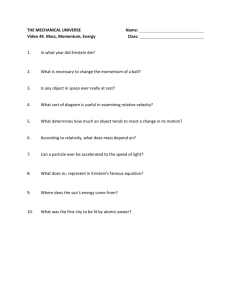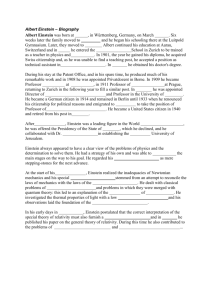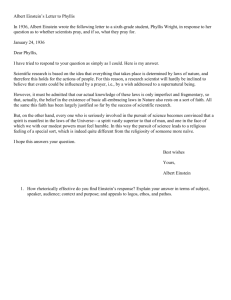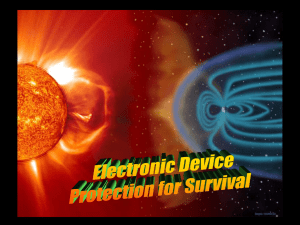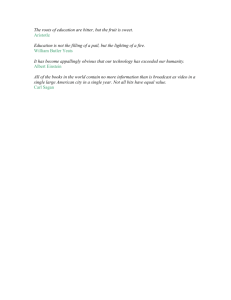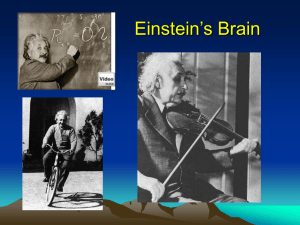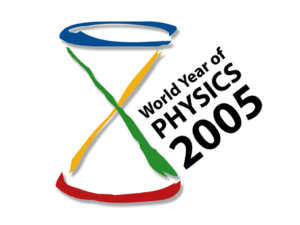Einstein - WordPress.com
advertisement
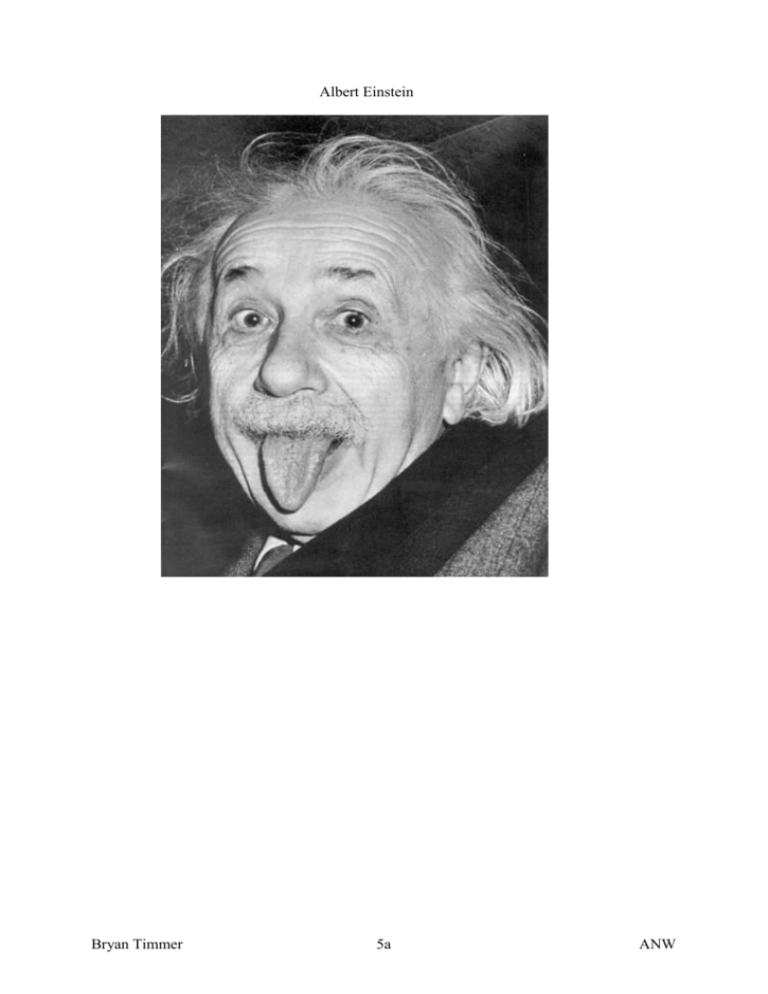
Albert Einstein Bryan Timmer 5a ANW General information Albert Einstein born on the 14th of March 1879 was one of the most famous scientists of the 20th century. He received the Nobel Prize in Physics in 1921. His theories of special and general relativity are of huge importance to many branches of physics and astronomy. They have been verified by many experiments and observations. Einstein is famous for his theories about light, matter, gravity, space, and time. His most famous equation is . It means that energy and mass are different forms of the same thing. Einstein published more than 300 scientific papers and over 150 non-scientific works. He received honorary doctorate degrees in science, medicine and philosophy from many European and American universities. On the eve of World War II, he helped alert President Franklin D. Roosevelt by warning him that Germany might be developing an atomic weapon. He recommended that the U.S. should begin to do nuclear research. That research, begun by a newly established Manhattan Project, resulted in the U.S. becoming the first and only country to have nuclear weapons during the war. He taught physics at the Institute for Advanced Study at Princeton, New Jersey, until his death in 1955. Bryan Timmer 5a ANW His life Einstein was born at Ulm in Württemberg, Germany, on March 14, 1879. His family was Jewish but was not very religious. However, later in life Einstein became very interested in his Judaism. Einstein did not begin speaking until after age two. When Einstein was around four, his father gave him a magneticcompass. He tried hard to understand how the needle could seem to move itself so that it always pointed north. The needle was in a closed case, so clearly nothing like wind could be pushing the needle around, and yet it moved. So in this way Einstein became interested in studying scienceand mathematics. His compass inspired him to explore the world. When he became older, he went to a school in Switzerland. After he graduated, he got a job in the patent office there. While he was working there, he wrote the papers that made him famous as a great scientist. In 1917, Einstein became very sick with an illness that almost killed him. It was his cousin Elsa Lowenthal who nursed him back to health. After this happened, Einstein divorced Mileva, and married Elsa on June 2, 1919. Just before the start of World War I, he moved back to Germany, and became director of a school there. He lived in Berlin until the Nazi government came to power. The Nazis hated people who were Jewish or who came from Jewish families. They accused Einstein of helping to create "Jewish physics," and German physicists tried to prove that his theories were wrong. In 1933, under death threats from the Nazis and despised by the Nazi-controlled German press, Einstein and Elsa moved to the United States to Princeton, New Jersey, after feeling the heat of Nazi Germany, and in 1940 he became a United States citizen. During World War II, Einstein and Leó Szilárd wrote to the U.S. president, Franklin D. Roosevelt, to say that the United States should invent an atomic bomb before the Nazi government could invent one first. He was the only one who signed the letter. He was, however, not part of the Manhattan Project, which was the project to create the atomic bomb. Einstein died on 18 April 1955 of a burst aorta, an aneurysm. He was still writing about quantum physics hours before he died. Bryan Timmer 5a ANW E=mc2 E=mc2, also called the mass-energy equivalence, is one of the things that Einstein is most famous for. It is a famous equation in physics and math that shows what happens when mass changes to energy or energy changes to mass. The "E" in the equation stands for energy. Energy is a number which you give to objects depending on how much they can change other things. For instance, a brick hanging over an egg can put enough energy onto the egg to break it. A feather hanging over an egg does not have enough energy to hurt the egg. There are three basic forms of energy: potential energy, kinetic energy, and rest energy. Two of these forms of energy can be seen in the examples given above, and in the example of a pendulum. A cannon ball hangs on a rope from an iron ring. A horse pulls the cannon ball to the right side. When the cannon ball is released it will move back and forth as diagrammed. It would do that forever except that the movement of the rope in the ring and rubbing in other places causes friction, and the friction takes away a little energy all the time. If we ignore the losses due to friction, then the energy provided by the horse is given to the cannon ball as potential energy. (It has energy because it is up high and can fall down.) As the cannon ball swings down it gains more and more speed, so the nearer the bottom it gets the faster it is going and the harder it would hit you if you stood in front of it. Then it slows down as its kinetic energy is changed back into potential energy. "Kinetic energy" just means the energy something has because it is moving. "Potential energy" just means the energy something has because it is in some higher position than something else. When energy moves from one form to another, the amount of energy always remains the same. It cannot be made or destroyed. This rule is called the "conservation law of energy". For example, when you throw a ball, the energy is transferred from your hand to the ball as you release it. But the energy that was in your hand, and now the energy that is in the ball is the same number. For a long time, people thought that the conservation of energy was all there was to talk about. When energy transforms into mass, the amount of energy does not remain the same. When mass transforms into energy, the amount of energy also does not remain the same. However, the amount of matter and energy remains the same. Energy turns into mass and mass turns into energy in a way that is defined by Einstein's equation, E = mc2. The "m" in Einstein's equation stands for mass. Mass is the amount of matter there is in some body. If you knew the number of protons and neutrons in a piece of matter such as a brick, Bryan Timmer 5a ANW then you could calculate its total mass as the sum of the masses of all the protons and of all the neutrons. (Electrons are so small that they are almost negligible.) Masses pull on each other, and a very large mass such as that of the Earth pulls very hard on things nearby. You would weigh much more on Jupiter than on Earth because Jupiter is so huge. You would weigh much less on the Moon because it is only about one-sixth the mass of Earth. Weight is related to the mass of the brick (or the person) and the mass of whatever is pulling it down on a spring scale — which may be smaller than the smallest moon in the solar system or larger than the Sun. Mass, not weight, can be transformed into energy. Another way of expressing this idea is to say that matter can be transformed into energy. Units of mass are used to measure the amount of matter in something. The mass or the amount of matter in something determines how much energy that thing could be changed into. Energy can also be transformed into mass. If you were pushing a baby buggy at a slow walk and found it easy to push, but pushed it at a fast walk and found it harder to move, then you would wonder what was wrong with the baby buggy. Then if you tried to run and found that moving the buggy at any faster speed was like pushing against a brick wall, you would be very surprised. The truth is that when something is moved then its mass is increased. Human beings ordinarily do not notice this increase in mass because at the speed humans ordinarily move the increase in mass in almost nothing. As speeds get closer to the speed of light, then the changes in mass become impossible not to notice. The basic experience we all share in daily life is that the harder we push something like a car the faster we can get it going. But when something we are pushing is already going at some large part of the speed of light we find that it keeps gaining mass, so it gets harder and harder to get it going faster. It is impossible to make any mass go at the speed of light because to do so would take infinite energy. Bryan Timmer 5a ANW Sources: http://simple.wikipedia.org/wiki/Albert_Einstein http://en.wikipedia.org/wiki/Albert_Einstein Bryan Timmer 5a ANW
